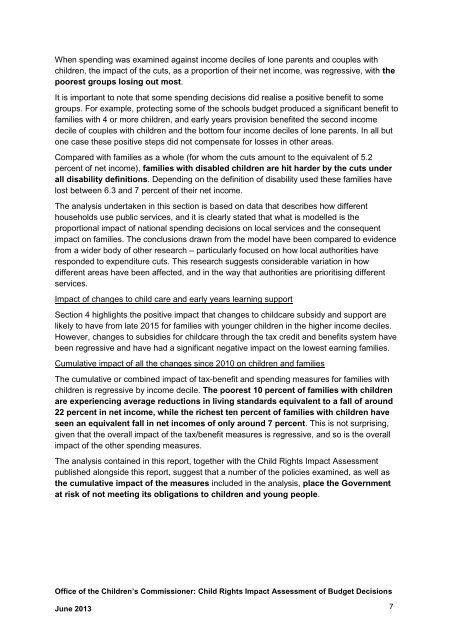force_download.php?fp=/client_assets/cp/publication/676/A_Child_Rights_Impact_Assessment_of_Budget_Decisions
force_download.php?fp=/client_assets/cp/publication/676/A_Child_Rights_Impact_Assessment_of_Budget_Decisions
force_download.php?fp=/client_assets/cp/publication/676/A_Child_Rights_Impact_Assessment_of_Budget_Decisions
Create successful ePaper yourself
Turn your PDF publications into a flip-book with our unique Google optimized e-Paper software.
When spending was examined against income deciles <strong>of</strong> lone parents and couples with<br />
children, the impact <strong>of</strong> the cuts, as a proportion <strong>of</strong> their net income, was regressive, with the<br />
poorest groups losing out most.<br />
It is important to note that some spending decisions did realise a positive benefit to some<br />
groups. For example, protecting some <strong>of</strong> the schools budget produced a significant benefit to<br />
families with 4 or more children, and early years provision benefited the second income<br />
decile <strong>of</strong> couples with children and the bottom four income deciles <strong>of</strong> lone parents. In all but<br />
one case these positive steps did not compensate for losses in other areas.<br />
Compared with families as a whole (for whom the cuts amount to the equivalent <strong>of</strong> 5.2<br />
percent <strong>of</strong> net income), families with disabled children are hit harder by the cuts under<br />
all disability definitions. Depending on the definition <strong>of</strong> disability used these families have<br />
lost between 6.3 and 7 percent <strong>of</strong> their net income.<br />
The analysis undertaken in this section is based on data that describes how different<br />
households use public services, and it is clearly stated that what is modelled is the<br />
proportional impact <strong>of</strong> national spending decisions on local services and the consequent<br />
impact on families. The conclusions drawn from the model have been compared to evidence<br />
from a wider body <strong>of</strong> other research – particularly focused on how local authorities have<br />
responded to expenditure cuts. This research suggests considerable variation in how<br />
different areas have been affected, and in the way that authorities are prioritising different<br />
services.<br />
<strong>Impact</strong> <strong>of</strong> changes to child care and early years learning support<br />
Section 4 highlights the positive impact that changes to childcare subsidy and support are<br />
likely to have from late 2015 for families with younger children in the higher income deciles.<br />
However, changes to subsidies for childcare through the tax credit and benefits system have<br />
been regressive and have had a significant negative impact on the lowest earning families.<br />
Cumulative impact <strong>of</strong> all the changes since 2010 on children and families<br />
The cumulative or combined impact <strong>of</strong> tax-benefit and spending measures for families with<br />
children is regressive by income decile. The poorest 10 percent <strong>of</strong> families with children<br />
are experiencing average reductions in living standards equivalent to a fall <strong>of</strong> around<br />
22 percent in net income, while the richest ten percent <strong>of</strong> families with children have<br />
seen an equivalent fall in net incomes <strong>of</strong> only around 7 percent. This is not surprising,<br />
given that the overall impact <strong>of</strong> the tax/benefit measures is regressive, and so is the overall<br />
impact <strong>of</strong> the other spending measures.<br />
The analysis contained in this report, together with the <strong>Child</strong> <strong>Rights</strong> <strong>Impact</strong> <strong>Assessment</strong><br />
published alongside this report, suggest that a number <strong>of</strong> the policies examined, as well as<br />
the cumulative impact <strong>of</strong> the measures included in the analysis, place the Government<br />
at risk <strong>of</strong> not meeting its obligations to children and young people.<br />
Office <strong>of</strong> the <strong>Child</strong>ren’s Commissioner: <strong>Child</strong> <strong>Rights</strong> <strong>Impact</strong> <strong>Assessment</strong> <strong>of</strong> <strong>Budget</strong> <strong>Decisions</strong><br />
June 2013 7



